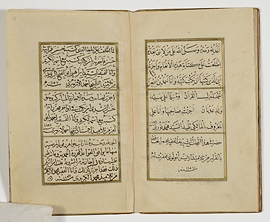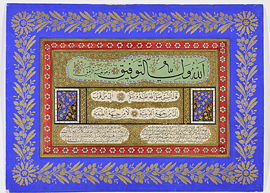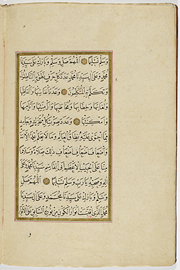“Handwriting is jewelry fashioned by the hand from the pure gold of the intellect.”3 The granting of certificates or diplomas (ijāzāt) for individual works is one of the hallmarks of the Islamic manuscript age. Certificates in such disciplines as Tradition (Ḥadīth) were granted as early as the 9th century. The granting of diplomas to calligraphers appears to have started in the 14th century during the Mamluk period and became characteristic of Ottoman practice during the 17th, 18th and the 19th centuries. A typical diploma of the period consisted of a decorated composition, executed usually in two scripts: a large thuluth (top line) and regular size naskh (main field). The composition traditionally consisted of quotations from Muslim tradition or well-known sayings or proverbs. The certificate itself was inscribed in a cartouche at the bottom of the work. Some pieces, however, may have two or more certificates by several master calligraphers. The main element of the certificate was the expression “I give him permission to use the word kataba” (literally, “to write”) at the end of a calligraphic piece (qiṭʿah). The certificates were usually inscribed by master calligraphers in a script (khaṭṭ) that takes its name from the word “certificate” (ijāzah), thus, khaṭṭ al-ijāzah. Short compositions were usually mounted on one piece of cardboard. Longer compositions, on the other hand, were made into a portfolio, folded in the middle, with the writing and decorations spread over two pages. Certificates were also attached to longer pieces of work, such as a short chapter from the Qurʾan, for instance, sūrat 77 (al-Mursalāt), copied in 1769-70 by Muḥammad Amīn Afandī (AC157), or a tract on calligraphy, as is the case with the work of ʿAbd Allāh al-Anīs (d.1746), transcribed by the Egyptian calligrapher Ḥasan al- Rushdī in 1744-5 (AC156).
3 Hishām ibn al-Ḥakam (9th century).





